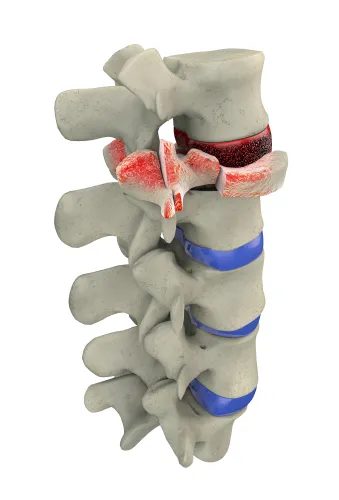Follow 3 C's to Capture Radiological Supervision During Vertebroplasty

This detail helps separate vertebroplasty from kyphoplasty.
If surgeons in your facility perform vertebroplasties, be sure you understand the procedure and capture all the components. Our experts share top tips on reporting radiological assistance during the procedure.
Clarify What the Surgeon Is Doing
Vertebroplasty is a minimally invasive, image-guided therapy used to relieve pain from a vertebral body fracture. Physicians operating in an outpatient facility normally perform percutaneous vertebroplasty instead of using an open surgical approach. When using the percutaneous approach, the physician injects specialized cement into the affected vertebral bodies. The cement hardens within the vertebra to provide stabilization and strength.
Caution: Don’t confuse vertebroplasty with kyphoplasty. Both procedures involve percutaneous injection of cement under imaging guidance, but kyphoplasty also involves placement of a balloon catheter to reduce the fracture before the cement is injected. Seeing terms such as "balloon," "bone tamp," "KyphXTM" (a common brand name for the bone tamp), or "IBT" (for "inflatable bone tamp") in the documentation signal that you should be coding for kyphoplasty. For kyphoplasty, you’ll turn to codes 22523-+22525 (Percutaneous vertebral augmentation, including cavity creation [fracture reduction and bone biopsy included when performed] using mechanical device, 1 vertebral body, unilateral or bilateral cannulation [e.g., kyphoplasty]; …).
Choose the Correct Number of Codes
CPT® 2013 includes three codes for percutaneous vertebroplasty:
22520 -- Percutaneous vertebroplasty (bone biopsy included when performed), 1 vertebral body, unilateral or bilateral injection; thoracic
22521 -- … lumbar
+22522 -- … each additional thoracic or lumbar vertebral body (List separately in addition to code for primary procedure).
Begin your coding by selecting either 22520 or 22521, depending on whether the surgeon treated thoracic or lumbar vertebrae. Submit one code for the initial vertebra in each spinal area, then include +22522 for each additional vertebra in that spinal area.
Detail 1: Note that the codes apply to either unilateral or bilateral procedures. Therefore, do not append modifier 50 (Bilateral procedure) or expect additional reimbursement if the surgeon injects both sides of the same vertebral body.
Detail 2: The descriptors were revised in 2012 to specify that the codes include bone biopsy. If the surgeon completes a bone biopsy at the same spinal level as the vertebroplasty, do not include 20225 (Biopsy, bone, trocar, or needle; deep [eg, vertebral body, femur]) on the claim.
Detail 3: The bulls-eye symbol beside codes 22521-22522 in CPT® shows that the services include moderate sedation. Do not include codes 99143-+99150 (Moderate sedation services [other than those services described by codes 00100-01999] …) on the vertebroplasty claim.
Check Whether Modifier 26 Applies
During vertebroplasty, the surgeon will use imaging guidance when positioning the needle or to assess the injection technique.
Report the radiological supervision with codes 72291 (Radiological supervision and interpretation, percutaneous vertebroplasty, vertebral augmentation, or sacral augmentation [sacroplasty], including cavity creation, per vertebral body or sacrum; under fluoroscopic guidance) or 72292 (Radiological supervision and interpretation, percutaneous vertebroplasty, vertebral augmentation, or sacral augmentation [sacroplasty], including cavity creation, per vertebral body or sacrum; under CT guidance) depending upon whether the surgeon uses computed tomography (CT) or fluoroscopic guidance.
For professional services billing, append modifier 26 (Professional component) to the guidance code because the procedure is performed in a facility setting.
"Modifier 26 would be added for the provider’s claim unless the provider owned the fluoroscopy equipment," explains Kristi Stumpf, MCS-P, CPC, COSC, ACS-OR, owner of Precision Auditing and Coding and senior orthopedic coder and auditor for The Coding Network in Washington. "If the equipment is physician owned, the full work value would be reported. CPT® codes 72291 and 72292 both carry a PT/TC indicator of ‘1’, indicating that the procedures have both a technical and professional component."
Criteria: "If you append modifier 26, you must save a hard copy of the image(s), and you must dictate a separate procedural report, and sign it (or electronically sign it) separately," says Bill Mallon, MD, medical director, Triangle Orthopedic Associates, Durham, N.C.
Coding example: The surgeon performs vertebroplasty at T12 and L1 and uses fluoroscopic guidance. You’ll report codes 22520, 72291-26, and +22522, says Heidi Stout, BA, CPC, COSC, PCS, CCS-P, with Coder on Call, Inc., in Milltown, N.J., and the orthopedic coding division director for The Coding Network, LLC, in Beverly Hills, Ca.
Final tip: If your payer is Medicare, watch for the edit for radiological supervision services. ‘CPT® codes 72291 and 72292 are to be reported per segment," Stumpf says. "Medicare has a medically unlikely edit of ‘3’ for the radiological supervision services -- keep an eye out for this restriction for your Medicare carriers."

